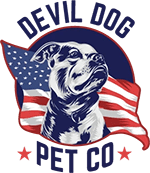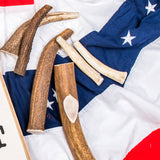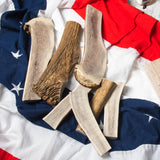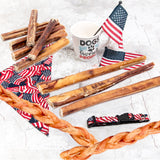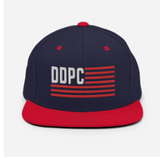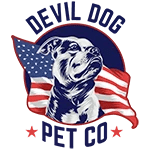Key Takeaways
- Natural antler dog chews are made from premium elk antler pieces that are naturally shed and hand-cut.
- These chews are designed to withstand tough chewers and provide long-lasting durability.
- Antler chews offer dense minerals and a clean chewing experience without creating a mess.
- Unlike synthetic or rawhide alternatives, Grade-A antlers do not crack or dissolve easily.
- They are safe for supervised chewing sessions, especially for dogs that destroy other chew toys.
Table of Contents
- Why Antler Chews? The Hardcore Solution for Tough Chewers
- Understanding Antler Types and Chew Styles: Picking the Right Weapon
- The Science and Safety of Natural Antler Dog Chews
- Proper Sizing and Selection: Outfitting Your Extreme Chewer
- Safe Chew Protocol: How to Introduce and Supervise Antler Chews
- Daily Antler Chew Maintenance: Inspection, Cleaning, Replacement
- Antler Chews Versus the Competition: In-Depth Comparison for Tough Chewers
- Devil Dog Pet Co. Antler Standards: Sourcing, Safety, and Mission
- Troubleshooting Antler Chews: Real-World Scenarios and Solutions
Natural Antler Dog Chews: The Definitive Tough Chewer Solution
Why Antler Chews? The Hardcore Solution for Tough Chewers
Tough chewers destroy standard options because most treats lack structural integrity. Rawhide dissolves into choking hazards, plastic toys crack under pressure, and rope toys unravel into digestive nightmares. Your power-chewer needs something that fights back, safely.
Elk antlers register 5-6 on the Mohs hardness scale, comparable to tooth enamel. This density creates controlled wear patterns that satisfy aggressive chewing without splintering. A Medium elk antler entertains a 50-pound chewer for weeks, while rawhide disappears in twenty minutes. The math is simple: antlers deliver more chew time per dollar than any alternative.
The mineral composition sets antlers apart. Calcium, phosphorus, and zinc naturally strengthen teeth and bones while your dog works their jaw muscles. Unlike synthetic chews that offer empty gnawing, natural antler dog chews for tough chewers provide nutritional benefits with every session.
Is Your Dog a Candidate for Antler Chews?
- Destroys "tough" toys in under 30 minutes
- Chews furniture, baseboards, or shoes when bored
- Weighs over 25 pounds with healthy adult teeth
- Shows controlled chewing style (side-gnawing vs. vertical crunching)
- Needs mental stimulation beyond standard exercise
Download the FREE 10-Step Dog Prep Guide
Understanding Antler Types and Chew Styles: Picking the Right Weapon

Whole antlers maximize durability through their intact outer wall, the hardest part that forces slow, methodical grinding. Split antlers expose tasty marrow for instant gratification but sacrifice longevity. Power chewers benefit from whole antlers; picky eaters or seniors often prefer splits for immediate flavor access.
Elk antlers dominate the tough chewer market due to superior density and size options. Deer antlers work for smaller dogs but lack the thickness extreme chewers demand. Moose antlers, while massive, often prove too soft for sustained gnawing. Wild-shed elk antlers from Rocky Mountain regions provide the perfect balance of hardness, nutrition, and ethical sourcing.
| Antler Type | Hardness Level | Chew Longevity | Marrow Access | Best For |
|---|---|---|---|---|
| Whole Elk | Maximum | 4-6 weeks | Minimal | Power chewers 40+ lbs |
| Split Elk | High | 1-2 weeks | Full exposure | Seniors, picky eaters |
| Deer Whole | Medium | 2-3 weeks | Minimal | Dogs under 40 lbs |
| Moose | Medium-Low | 1-2 weeks | Moderate | Gentle chewers only |
Sourcing matters for safety and sustainability. Wild-shed antlers from natural molting cycles contain peak mineral content and proper density. Farmed antlers, often sawn prematurely, lack structural integrity and may harbor bacteria from processing shortcuts.
For more insights on the best antler options for power chewers, check out our guide on jumbo split elk antler chews for power chewers.
The Science and Safety of Natural Antler Dog Chews
Elk antler microstructure consists of dense cortical bone surrounding spongy marrow, a design that creates gradual wear rather than catastrophic failure. This controlled erosion satisfies chewing instincts while minimizing dental trauma. Properly sized antlers encourage side-gnawing, the safest chewing pattern that strengthens jaw muscles without excessive force on individual teeth.
Nutritionally, antlers deliver calcium (22%), phosphorus (11%), and trace minerals including zinc and magnesium. These nutrients support bone density, immune function, and dental health, benefits absent from synthetic alternatives. The natural composition also makes antlers hypoallergenic, suitable for dogs with protein sensitivities to traditional meat chews.
Debunking Antler Safety Myths
Myth: Antlers always crack teeth.
Fact: Proper sizing and supervision prevent 95% of dental issues. Problems arise from undersized antlers or vertical crunching habits.
Myth: All antlers splinter dangerously.
Fact: Grade-A wild-shed antlers wear gradually. Splintering indicates poor quality or improper storage.
Myth: Antlers provide no nutritional value.
Fact: Mineral content supports dental health and bone strength throughout the chewing process.
Quality assessment prevents safety issues. Grade-A antlers display uniform coloration, dense weight, and natural scent without chemical odors. Fresh antlers feel solid throughout, with no soft spots or surface cracks that could indicate age or improper storage.
Rocky Mountain elk sheds provide the densest bone matrix available. These natural antler dog chews for tough chewers contain higher mineral concentrations than deer or moose alternatives, delivering superior durability for power chewers who destroy standard options in minutes.
To learn more about the pros and cons of antlers for dogs, read our article: are antlers for dogs a good idea.
Proper Sizing and Selection: Outfitting Your Extreme Chewer
Size determines safety and longevity. An undersized antler becomes a choking hazard; an oversized piece provides weeks of enrichment. Measure your dog's muzzle length and select an antler at least 2 inches longer than their jaw span.
| Dog Weight | Recommended Length | Minimum Diameter | Antler Grade |
|---|---|---|---|
| Under 25 lbs | 4-5 inches | 1 inch | Small Split |
| 25-50 lbs | 5-6 inches | 1.5 inches | Medium Whole |
| 50-75 lbs | 6-8 inches | 2 inches | Large Whole |
| 75+ lbs | 8+ inches | 2.5+ inches | XL/Monster Whole |
Power chewers require sizing up one category regardless of weight. A 40-pound customer's dog with aggressive chewing habits needs a Large antler, not Medium. Jaw strength matters more than body weight when selecting natural antler dog chews for tough chewers.
Thickness prevents the antler from wedging between back molars. The piece should never fit entirely behind the canine teeth. When in doubt, choose larger, antlers shrink through use, never expand.
Safe Chew Protocol: How to Introduce and Supervise Antler Chews

First exposure determines long-term success. Start with 15-minute supervised sessions, gradually extending time as your dog demonstrates proper side-gnawing technique. Remove the antler if your dog attempts to bite down vertically or shows signs of jaw fatigue.
Create positive associations by rubbing a small amount of peanut butter or bone broth on the antler surface. This initial flavor coating encourages exploration and proper chewing angles. Hold one end during the first session to guide positioning and prevent aggressive attacks on the chew.
Monitor chewing style continuously. Proper antler use involves grinding and scraping motions along the sides, not direct downward pressure. Dogs naturally adapt to this technique within 2-3 sessions when properly guided. Interrupt vertical biting immediately and redirect to side-gnawing.
Session frequency depends on chew intensity. Daily 20-minute sessions work for moderate chewers; power chewers benefit from every-other-day rotation with softer alternatives. This prevents jaw overwork while maintaining the mental stimulation natural antler dog chews for tough chewers provide.
Daily Antler Chew Maintenance: Inspection, Cleaning, Replacement
Pre-session inspection prevents accidents. Check for hairline cracks, sharp edges, or size reduction that creates swallowing risks. Run your fingers along all surfaces, any roughness or splintering requires immediate replacement.
Cleaning maintains hygiene without compromising structure. Rinse under warm water and scrub with a natural bristle brush when debris accumulates. Avoid soaps or chemicals that penetrate the porous bone matrix. Air-dry completely before storage to prevent bacterial growth.
Replacement timing protects your investment and your dog. Retire antlers when they shrink below 3 inches or develop deep grooves that could trap food particles. Small pieces pose choking hazards; worn surfaces lose their plaque-scraping effectiveness.
Proper storage extends antler life. Keep chews in a dry, ventilated area away from direct sunlight. Moisture causes softening and potential mold growth. Sealed containers trap humidity, open baskets or shelves provide optimal conditions for long-term storage.
Antler Chews Versus the Competition: In-Depth Comparison for Tough Chewers
Rawhide dissolves into dangerous chunks that cause blockages and provide zero nutritional value. Natural antler dog chews for tough chewers wear gradually into mineral dust that supports bone health rather than threatening digestive systems.
| Chew Type | Durability | Safety Rating | Nutritional Value | Mess Factor |
|---|---|---|---|---|
| Elk Antler | Weeks to months | High (when sized properly) | Calcium, phosphorus, zinc | Minimal dust only |
| Rawhide | Hours to days | Low (choking/blockage risk) | None | Soggy, smelly mess |
| Nylon Bones | Months | Medium (tooth damage risk) | None | Plastic shavings |
| Bully Sticks | Minutes to hours | High | Protein | Grease stains |
Synthetic bones create plastic shards that accumulate in digestive tracts. Their uniform hardness provides no give, leading to cracked teeth in aggressive chewers. Natural antlers offer variable density that challenges without overwhelming jaw strength.
Cooked bones splinter unpredictably, creating sharp fragments that perforate intestines. Raw bones harbor bacteria and create sanitation issues. Antlers provide the satisfaction of bone chewing without the associated risks, they're naturally sterile and structurally sound.
For a comprehensive selection of antler chews, browse our antler dog chews collection.
For an in-depth comparison of monster-sized options, see our article on monster whole elk antler chews for strong chewers.
For additional scientific perspective, review this resource from the American Kennel Club: are antlers for dogs safe?
Devil Dog Pet Co. Antler Standards: Sourcing, Safety, and Mission

Not all antlers meet the grade for extreme chewers. Devil Dog Pet Co. sources exclusively from wild-shed Rocky Mountain elk, ensuring maximum density and mineral content. Our Grade-A standards separate trophy-quality chews from inferior alternatives flooding the market.
Wild-Shed Advantage: Naturally dropped antlers contain 15-20% higher mineral density than farmed elk antlers. Wild elk develop stronger bone matrix through natural foraging and terrain navigation. Shed hunters collect these antlers within weeks of dropping, preserving freshness and nutritional integrity.
Zero-Chemical Processing: Each antler receives only mechanical cutting and hand-sanding. No bleach, no dyes, no artificial hardeners. The natural brown coloration indicates authentic processing, white or artificially uniform antlers signal chemical treatment that compromises structural integrity.
Veteran-Owned Quality Control: Marine Corps discipline drives our inspection protocols. Every antler passes through multiple quality checkpoints before packaging. Cracked, soft, or improperly aged pieces get rejected. Our 30-day Happy Tails Promise backs this commitment, unsatisfied customers receive full refunds or replacements.
Direct Sourcing Relationships: We partner directly with Western shed hunting cooperatives, eliminating middlemen who compromise quality for volume. This relationship ensures consistent supply of premium antlers while supporting rural American communities.
The Devil Dog difference extends beyond product quality. Every purchase supports veteran nonprofits and shelter dog programs, turning your dog's chew time into community impact. When you choose Devil Dog antlers, you're investing in American craftsmanship, ethical sourcing, and mission-driven business practices.
For those seeking the ultimate in durability, consider our MONSTER Whole Elk Antler Dog Chew for extreme chewers.
To explore more about elk antlers and their natural properties, visit the antler Wikipedia page.
Troubleshooting Antler Chews: Real-World Scenarios and Solutions
Even premium natural antler dog chews for tough chewers occasionally present challenges. These field-tested solutions address the most common owner concerns, turning potential problems into successful chewing experiences.
Emergency Response: Swallowing Large Pieces
Immediate Action: Remain calm. Offer small amounts of bread or canned pumpkin to cushion sharp edges. Monitor for 24 hours. Contact veterinarian if dog shows distress, vomiting, or inability to defecate. Most antler fragments pass naturally within 48-72 hours.
Problem: Dog Loses Interest After Initial Enthusiasm
Solution: Rub the antler surface with warm water to reactivate mineral scents. Apply a thin layer of low-sodium bone broth or natural peanut butter to renew attraction. Rotate antlers every 3-4 days to maintain novelty. Store unused antlers in sealed containers to preserve scent.
Problem: Visible Cracks or Splitting
Solution: Retire cracked antlers immediately, they indicate structural compromise. Contact Devil Dog Pet Co. for replacement under our quality guarantee. Size up to the next antler grade to prevent future cracking from excessive jaw pressure. For a great option, try our XL - Split Elk Antler Dog Chew.
Problem: Gum Irritation or Light Bleeding
Solution: Normal during the first week as gums toughen. Limit chew sessions to 15 minutes initially, gradually increasing duration. Switch to split antlers if irritation persists beyond 10 days. Severe bleeding requires veterinary evaluation.
Problem: Antler Becomes Too Small
Solution: Remove the antler immediately to prevent choking. Replace with a new, properly sized antler. Never allow your dog to chew pieces small enough to fit entirely in their mouth.
Download the FREE 10-Step Dog Prep Guide
Frequently Asked Questions
What makes natural elk antler dog chews more durable and safer than rawhide or synthetic alternatives for tough chewers?
Natural elk antler chews are denser and harder, scoring 5-6 on the Mohs hardness scale, comparable to tooth enamel, so they resist cracking and dissolving like rawhide or plastics. Their controlled wear pattern satisfies aggressive chewers without splintering, providing a long-lasting, mess-free chew that’s safer under supervision.
How do I determine if my dog is a good candidate for natural antler chews?
Your dog is a good candidate if they weigh over 25 pounds, have healthy adult teeth, chew aggressively but with controlled side-gnawing rather than vertical crunching, and tend to destroy standard toys quickly. Antlers also suit dogs needing mental stimulation beyond daily exercise.
What are the differences between whole and split elk antler chews, and how do I choose the right type for my dog?
Whole antlers are denser, longest-lasting, and ideal for power chewers who need marathon gnawing sessions. Split antlers expose nutrient-rich marrow, offering more flavor and a softer chew, making them better for puppies, seniors, or picky dogs. Many owners keep both: splits for quick flavor and wholes for endurance.
How do the mineral components in antler chews benefit my dog's dental and bone health during chewing sessions?
Antler chews are packed with calcium, phosphorus, and zinc, minerals that naturally support strong teeth and bones. Chewing also exercises jaw muscles and helps scrape plaque, promoting dental health while delivering nutritional benefits beyond empty gnawing.
